Small overlap front: driver-side
Rating applies to 2019-25 models
Tested vehicle: 2019 Toyota RAV4 XLE 4-door 4wd
The Toyota RAV4 was redesigned for the 2019 model year. The Toyota Venza was re-introduced to the market as a small SUV in the 2021 model year and shares the same platform as the RAV4. Driver-side small overlap frontal ratings are assigned by the Institute based on a test of a 2019 RAV4 conducted by Toyota.
| Evaluation criteria | Rating |
|---|---|
| Structure and safety cage | |
| Driver injury measures | |
| Head/neck | |
| Chest | |
| Hip/thigh | |
| Lower leg/foot | |
| Driver restraints and dummy kinematics | |
Small overlap front: passenger-side
Rating applies to 2019-25 models
Tested vehicle: 2019 Toyota RAV4 LE 4-door 4wd
The Toyota RAV4 was redesigned for the 2019 model year. The Toyota Venza was re-introduced to the market as a small SUV in the 2021 model year and shares the same platform as the RAV4. Two passenger-side small overlap frontal tests of the RAV4 were conducted, one by the Institute and the other by Toyota. Ratings are based on both tests, but the vehicle specifications shown below are based on the Institute’s test.
| Evaluation criteria | Rating |
|---|---|
| Overall evaluation | |
| Structure and safety cage | |
| Passenger injury measures | |
| Head/neck | |
| Chest | |
| Hip/thigh | |
| Lower leg/foot | |
| Passenger restraints and dummy kinematics | |
| Driver injury measures | |
| Head/neck | |
| Chest | |
| Hip/thigh | |
| Lower leg/foot | |
| Driver restraints and dummy kinematics | |

Action shot taken during the Institute's passenger-side small overlap frontal crash test.

The dummy's position in relation to the door frame and dashboard after the crash test indicates that the passenger's survival space was maintained very well (Institute test car shown).
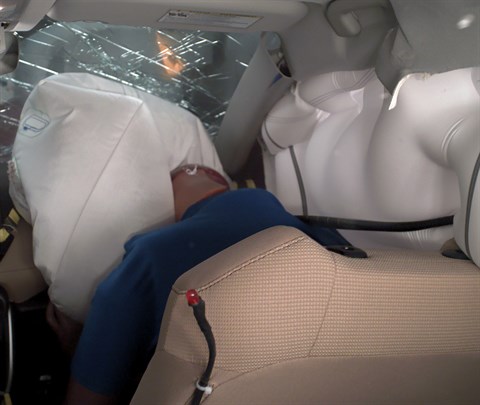
The frontal and side curtain airbags worked well together to keep the head from coming close to any stiff structure or outside objects that could cause injury (Institute test shown).

The passenger's space was maintained well in both tests, and in the Institute's test, risk of injuries to the dummy's legs and feet was low. (Risk of injury to the left lower leg was moderate in Toyota's test).
Moderate overlap front: original test
Rating applies to 2019-25 models
Tested vehicle: 2019 Toyota RAV4 XLE 4-door 4wd
The Toyota RAV4 was redesigned for the 2019 model year. The Toyota Venza was re-introduced to the market as a small SUV in the 2021 model year and shares the same platform as the RAV4. Moderate overlap frontal ratings are assigned by the Institute based on a test of a 2019 RAV4 conducted by Toyota.
| Evaluation criteria | Rating |
|---|---|
| Overall evaluation | |
| Structure and safety cage | |
| Driver injury measures | |
| Head/neck | |
| Chest | |
| Leg/foot, left | |
| Leg/foot, right | |
| Driver restraints and dummy kinematics | |
Moderate overlap front: updated test
Rating applies to 2021-25 models
Tested vehicle: 2021 Toyota RAV4 LE 4-door 4wd
The Toyota RAV4 was redesigned for the 2019 model year.
| Evaluation criteria | Rating |
|---|---|
| Overall evaluation | |
| Structure and safety cage | |
| Driver injury measures | |
| Head/neck | |
| Chest | |
| Thigh/hip | |
| Leg/foot | |
| Driver restraints and dummy kinematics | |
| Rear passenger injury measures | |
| Head/neck | |
| Chest | |
| Thigh | |
|
Rear passenger restraints and dummy kinematics
| |

View of the vehicle after the crash showing the airbags and damage to the occupant compartment.
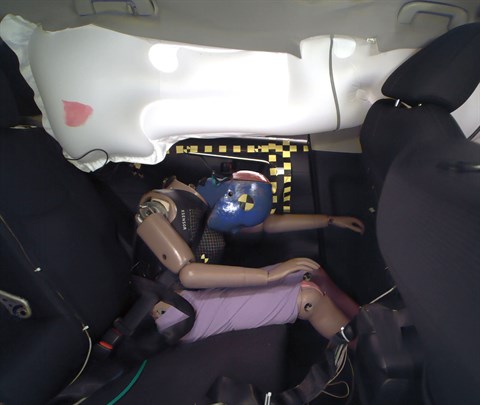
The rear passenger dummy's head remained a safe distance from the front seatback.
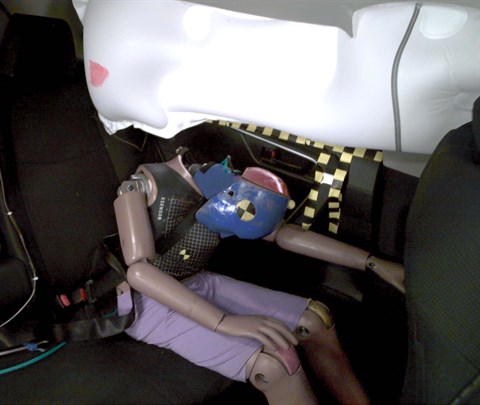
Rear passenger dummy injury values indicate a low risk of injury to the head or neck and chest. During the crash, the shoulder belt remained in an ideal position on the dummy’s chest.

The rear passenger dummy's lap belt moved from the ideal position on the pelvis onto the abdomen, increasing the risk of abdominal injuries.

During rebound the rear passenger dummy's head moved outside of the side curtain airbag. The head protection is inadequate and puts the head at risk of possible contact with outside objects.
Side: original test
Rating applies to 2019-25 models
Tested vehicle: 2019 Toyota RAV4 XLE 4-door 4wd
The Toyota RAV4 was redesigned for the 2019 model year. The Toyota Venza was re-introduced to the market as a small SUV in the 2021 model year and shares the same platform as the RAV4. Side ratings are assigned by the Institute based on a test of a 2019 RAV4 conducted by Toyota.
| Evaluation criteria | Rating |
|---|---|
| Overall evaluation | |
| Structure and safety cage | |
| Driver injury measures | |
| Head/neck | |
| Torso | |
| Pelvis/leg | |
| Driver head protection | |
| Rear passenger injury measures | |
| Head/neck | |
| Torso | |
| Pelvis/leg | |
| Rear passenger head protection | |
Side: updated test
Rating applies to 2019-25 models
Tested vehicle: 2021 Toyota RAV4 LE 4-door 4wd
The Toyota RAV4 was redesigned for the 2019 model year. The Toyota Venza was re-introduced to the market as a small SUV in the 2021 model year and shares the same platform as the RAV4. These ratings also apply to the Toyota RAV4 Prime, now known as the RAV4 Plug-in Hybrid beginning with 2025 models.
| Evaluation criteria | Rating |
|---|---|
| Overall evaluation | |
| Structure and safety cage | |
| Driver injury measures | |
| Head/neck | |
| Torso | |
| Pelvis | |
| Driver head protection | |
| Rear passenger injury measures | |
| Head/neck | |
| Torso | |
| Pelvis | |
|
Rear passenger head protection
Part of the dummy's head moved beyond the rear portion of the side curtain airbag and contacted the C-pillar hard. The head protection is inadequate. | |

View of the vehicle just after the crash test.
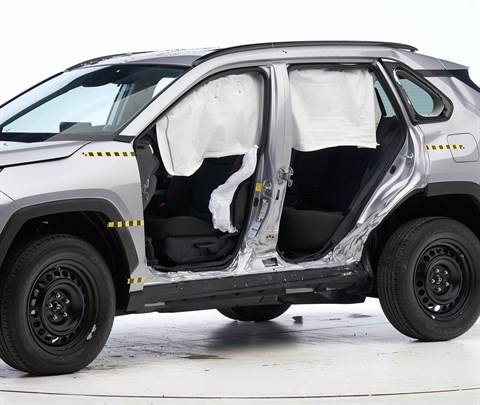
View of the vehicle after the crash with doors removed, showing the side airbags and damage to the occupant compartment.
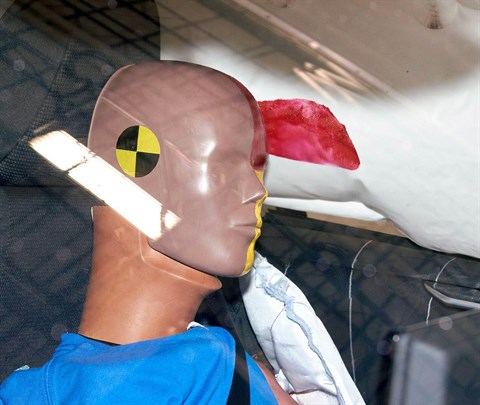
Smeared greasepaint shows where the driver dummy's head was protected from being hit by hard structures by the side airbags.
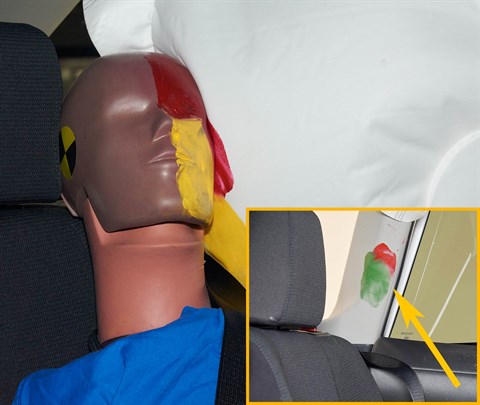
Smeared greasepaint shows where the rear passenger dummy's head struck the C-pillar (inset) despite the deployment of the side curtain airbag.
Roof strength
Rating applies to 2019-23 models
Tested vehicle: 2019 Toyota RAV4 LE 4-door 4wd
| Overall evaluation | |
|---|---|
| Curb weight | 3,500 lbs |
| Peak force | 21,009 lbs |
| Strength-to-weight ratio | 6.00 |
Head restraints & seats
Seat type: Manual cloth seat
| Overall evaluation | |
|---|---|
| Dynamic rating | |
| Seat/head restraint geometry |
About the head restraint & seat test
Currently, IIHS tests apply only to front seats.
Headlights
Ratings are given for 3 different headlight variations available on this vehicle.
Trim level(s)
- Hybrid Limited trim equipped with Adaptive Front Headlight System package
| Evaluation criteria | Rating |
|---|---|
| Low-beam headlight type | LED projector |
| High-beam headlight type | LED projector |
| Curve-adaptive? | Yes |
| High-beam assist? | Yes |
|
Overall rating | |
| Distance at which headlights provide at least 5 lux illumination: | |
Low beams
On the straightaway, visibility was good on both sides of the road. On curves, visibility was good in all 4 tests.
The low beams created some glare.
High beams
On the straightaway, visibility was good on the right side of the road and inadequate on the left side. On curves, visibility was good on both right curves and fair on both left curves.
High-beam assist compensates for some limitations of this vehicle's low beams on the gradual left curve.
Trim level(s)
- LE trim
- XLE trim
- XLE Premium trim
- Adventure trim
- Limited trim
- Hybrid LE trim
| Evaluation criteria | Rating |
|---|---|
| Low-beam headlight type | LED reflector |
| High-beam headlight type | LED reflector |
| Curve-adaptive? | No |
| High-beam assist? | Yes |
|
Overall rating | |
| Distance at which headlights provide at least 5 lux illumination: | |
Low beams
On the straightaway, visibility was good on the right side of the road and fair on the left side. On curves, visibility was fair on the sharp right and sharp left curves and inadequate on the gradual right and gradual left curves.
The low beams never exceeded glare limits.
High beams
On the straightaway, visibility was good on the right side of the road and inadequate on the left side. On curves, visibility was inadequate in all 4 tests.
High-beam assist compensates for some limitations of this vehicle's low beams on the straightaway, on both left curves and on both right curves.
Trim level(s)
- Hybrid XLE trim
- Hybrid XSE trim
- Hybrid Limited trim
| Evaluation criteria | Rating |
|---|---|
| Low-beam headlight type | LED projector |
| High-beam headlight type | LED projector |
| Curve-adaptive? | No |
| High-beam assist? | Yes |
|
Overall rating | |
| Distance at which headlights provide at least 5 lux illumination: | |
Low beams
On the straightaway, visibility was good on the right side of the road and fair on the left side. On curves, visibility was good on the gradual right curve, fair on the sharp right and sharp left curves, and inadequate on the gradual left curve.
The low beams created some glare.
High beams
On the straightaway, visibility was inadequate on both sides of the road. On curves, visibility was inadequate in all 4 tests.
High-beam assist compensates for some limitations of this vehicle's low beams on the straightaway and on the gradual left curve.
Front crash prevention: vehicle-to-vehicle
Front crash prevention: pedestrian (day)
Seat belt reminders
Rating applies to 2021-22 models
| Evaluation criteria | Rating |
|---|---|
| Overall evaluation | |
| Front row | |
| Unbelted occupant alert (audible & visual) | |
| Initiation time | |
| Duration | Long enough (90+ seconds) |
| Volume | |
| Audio frequency | |
| Second row | |
| Startup status alert (visual) | |
| Initiation time | |
| Duration at least 60 seconds | |
| Belt disengaged alert (audible & visual) | |
| Initiation time | |
| Duration at least 30 seconds | |
| Volume | |
| Audio frequency | |
Child seat anchors
Rating applies to 2019-25 models
| Evaluation criteria | Rating |
|---|---|
| Overall evaluation | + extra LATCH positions |
| Vehicle trim | LE |
| Seat type | cloth |
This vehicle has 2 rear seating positions with complete child seat attachment (LATCH) hardware.
It has 1 additional seating position with a tether anchor and the ability to borrow lower anchors from the other seating positions.
Note: When anchors are borrowed, they aren't available to use in their designated positions.
| Evaluation criteria | Rating |
|---|---|
| Overall evaluation | + extra LATCH positions |
| Vehicle trim | LE |
| Seat type | cloth |
| Rating icon | Rating |
|---|---|
| G | Good |
| A | Acceptable |
| M | Marginal |
| P | Poor |
| Seating positions that rely on borrowed lower anchors or have only a tether anchor available are not rated. | |
thether anchor symbol | Tether anchor |
lower anchor symbol | Lower anchors |
| Lower anchor(s) can be borrowed from adjacent positions(s) | |
| No hardware available |
Details by seating position
| Position | Rating |
|---|---|
| 1 | |
| Tether anchor | |
| easy-to-find location | |
| no other hardware could be confused for anchor | |
| Lower anchors | |
| not too deep in seat | |
| not too much force needed to attach | |
| easy to maneuver around anchors | |
| 2 | |
| Tether anchor | |
| easy-to-find location | |
| no other hardware could be confused for anchor | |
| Lower anchors | |
| Can be borrowed from 1 and 3 | |
| 3 | |
| Tether anchor | |
| easy-to-find location | |
| no other hardware could be confused for anchor | |
| Lower anchors | |
| not too deep in seat | |
| not too much force needed to attach | |
| easy to maneuver around anchors |
